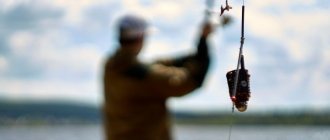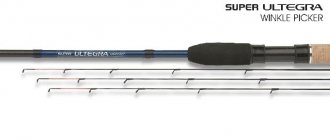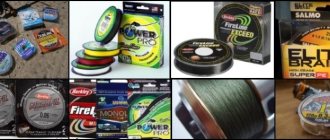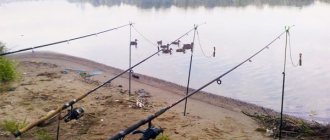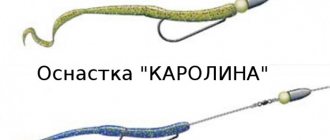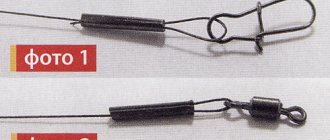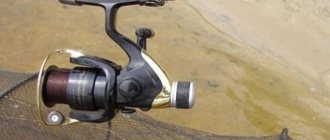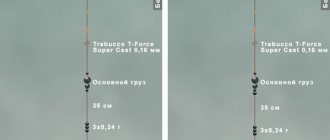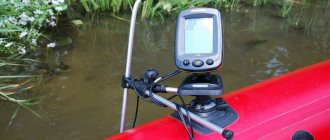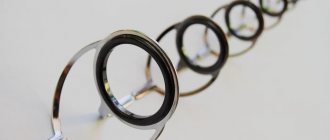Description
Mayfly
Mayfly (Latin Ephemeroptera - from the Greek "ephemeron" - fleeting, quickly passing, and "ptera" - wing). Mayflies are an ancient order of winged insects, including about 1,500 species, distributed throughout the globe except the Hawaiian Islands in the Pacific Ocean and St. Helena Island in the Atlantic Ocean. Mayflies are formed from larvae that live in silt and clay soils below the water level.
Characteristic features of mayflies are three (less often two) thin long tail filaments at the end of the abdomen. The mass emergence of mayflies occurs in mid-summer in the evening and lasts only a few days. The emerging mayfly literally fills the entire air space above the river and falls into the water like snow flakes, which is why its second name comes from the snowstorm.
Mayfly larva, or “granny,” is also a good bait. The larvae live in the clayey soil of the underwater shore or in dense tangles of underwater plants. The larvae are whitish in color, have two antennae in front and three fleecy tails in the back.
The mayfly order is divided into several families:
- Family BAETIDS (Baetidae)
. Representatives of the family live mainly in stagnant bodies of water and are characterized by legs pointing to the sides. - Family HEPTAGENIIA (Heptageniidae)
. The larvae have a moderately elongated body, flattened in the dorsoventral direction. Their legs are long, tenacious, their tail filaments are long - these larvae deftly crawl among stones and underwater plants. - Family Mayflies (Oligoneuridae)
. The larvae are distinguished by their large size and compressed body, and their tail filaments are short, shorter than the length of the body. - Family TRUE MAYFLY (Ephemeridae)
. Their larvae have an elongated cylindrical body with strong burrowing legs. These larvae dig tunnels in the clayey soil of slow-flowing rivers. - Family PROSOPISTOMIDS (Prosopistomidae)
. The larvae of this family are distinguished by a very wide, leaf-shaped, compressed body; their gills are hidden under the lateral processes of fused segments, so that they form a gill cavity. The tail appendages of these larvae resemble the fork of lower crustaceans. These larvae live in fast streams under stones.
There are about 2,000 species of mayflies known in the world. About 250 species have been recorded in Russia, about 100 of them are found in the European part. Our most common mayflies belong to the families Double-tailed, Thin-skinned, Seven-day and True mayflies. The most numerous and smallest are two-tailed mayflies. And the largest Russian species is the common mayfly, 15–20 mm long, with brown wings.
Features of reproduction
The reproduction of mayfly butterflies is preceded by their mass flight with swarming of insects, during which meetings of the sexes occur. At the same time, the females, quickly flapping their wings, rise up and then, freezing, begin to fall down. An approaching male fertilizes her and dies. Females lay eggs directly into the water, and clutch sizes can vary greatly.
Larva
Mayfly development
First, first instar larvae emerge from the eggs. The development of the offspring occurs over two years. After each regular molt, of which there are up to forty, the larvae become increasingly closer in appearance to the adult individual.
The penultimate phase—subimago—occurs on land. The insect still does not fly well. There is quite a lot of pubescence on the wings, making them matte. A few hours later, the final moult occurs, as a result of which an adult, sexually mature mayfly comes into the world.
What do mayfly larvae eat?
According to their way of life, the larvae belong to burrowing forms, breaking through impressive passages in the muddy bottom or clayey banks of rivers. Aquatic invertebrates trapped in such a labyrinth become prey for small predators. In addition, mayfly larvae feed on all sorts of decaying debris.
Finding and catching mayflies
Mayfly larva
Around the end of June, a gradual exodus of larvae from the water begins and winged insects resembling butterflies appear. Their aerial dance cannot be confused with the dance of any other butterfly: the insect quickly flies up, then smoothly falls and takes off again. The mayfly dances in the meadows adjacent to the water. If you happen to see this, then you will already know that a mayfly larva lives in this river or stream. To find out where there are mayflies and where they are not, you need to scoop up and disassemble the coastal mud. Sometimes the presence of a larva can be detected without this: in the coastal zone, numerous holes are visible on the clay bottom - these are larval passages. The larva does not like creeks and backwaters, where there is eternal stagnation and there is not even the slightest flow of water. The mud there is stinking, and the grandmother does not live in it. There are water burros, dragonfly larvae, leeches, etc., but no mayfly nymphs. There is no granny in clean sand either, and if there is, it is very small. Most of it is on the clay bottom the color of dark ocher. Where there are a lot of larvae, collecting them is not difficult even without any auxiliary equipment. Just a piece of board or a canna lid is enough, since the depth of the hole does not exceed 6 cm. The slurry is scooped onto the shore and the whole thing is dismantled, rinsed and moistened with water. The larvae are very clearly visible: they are disturbed and they are moving, all that remains is to collect them in a spacious container. When disassembling, you need to be careful, as with any living creature: many are harmless, but there are also those that bite, such as the smooth water bug. Its sting is strong and painful, like that of a wasp. It is called the water wasp. And there’s a lot of glass everywhere now, so don’t relax.
To wash the larvae, it is most convenient to use a special scoop made of steel mesh with a cell diameter of up to 5 mm and a volume of up to 4 liters. It is attached to a long pole, and if the shore and water allow, then it can be done without a pole. When there is heavy spring water, a rinsing bucket made of mesh, like those used by bloodworms, is indispensable. They throw him into the water on a strong rope and begin to drag him to the shore with short jerks. At first the bucket slides along the bottom, but after a couple of jerks it sinks into the silt, and you slowly pull it towards you. You can tell by the heaviness that the bucket is full, then you can safely pull it out of the water. The contents are washed in it, then the remainder is poured out and the nymphs are selected. You can take an ordinary metal bucket and do everything exactly the same. After you pull it ashore, dump out the contents and disassemble it, moistening it with water. On large rivers it is absolutely impossible to do without a bucket, since the larva is located at a distance from the banks, at a depth of 1.5 to 4 m.
How to collect mayflies?
The main time for collecting mayflies is July. It is at this time that the number of these insects reaches its peak values. Finding butterflies will not be difficult while fishing. They spin and dance on the lawns near the pond. It is better to catch them with butterfly nets. Fly fishermen successfully practice this method.
As for the larvae, they can be found in the coastal zone on clay. Sometimes you can see burrows in the ground underwater. There was a larva's house there. If you scoop up the soil and wash it like you wash bloodworms, you will probably find several larvae.
There is no point in looking for larvae in stagnant places where the silt gives off an unpleasant odor. You need to look for places with running water. A dark orange clay bottom with running water is the ideal living conditions for mayfly larvae.
When excavating soil on the shore, care must be taken. It’s better to take a small stick and use it to rake out the silt. The larvae easily reveal themselves by moving. Simply pry them off and place them in the attachment box. You shouldn’t test your body’s strength by trying to move the soil with your hands. There may be bugs that can bite quite well there.
For washing, it is better to use a scoop with a long handle, which is successfully used by bloodworms.
Mayfly for catching
The mayfly fly (an escaped specimen) and its larva are used as bait for fishing.
The first one is collected during the emergence period; roach, bream, ide, and chub bite well on it. It does not last long, dries out quickly and crumbles. You can slow down its deterioration by placing it in the refrigerator.
Small hooks are used to catch insects. Place two mayfly flies and pass the sting through the breast.
Dead mayflies are also used for fishing, but only as an additive to bait.
What does a mayfly larva look like?
But the larvae of these insects develop in water. They have a slender body and developed legs, as well as tufts of tracheal gills on either side of the abdomen. One mayfly larva has seven pairs of gills, similar to flat oval plates.
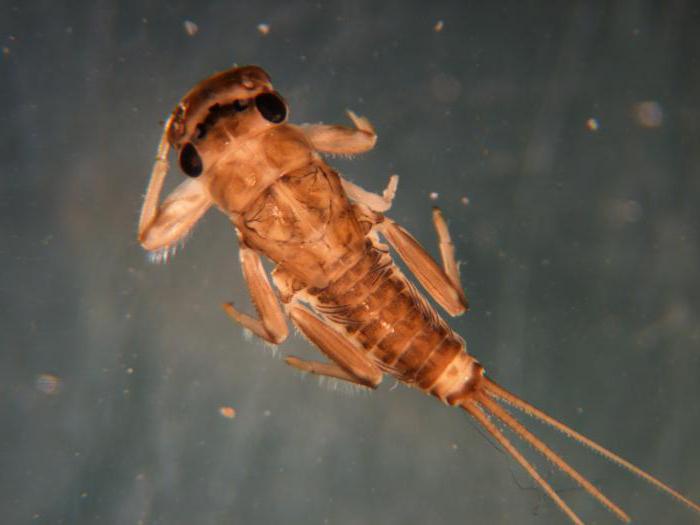
The first six pairs always oscillate, but the seventh remains motionless. First, the first pair begins to move, followed by the second, etc. Thus, a constant flow of water is formed, running from the front to the rear gills. An interesting fact is that in water enriched with oxygen, the movement of the gills is significantly slowed down. But if there is not enough oxygen, then they move so intensely that a “shine” effect is created around them.
Features of fishing for mayfly
For fishing, short (~ 3 m) bamboo rods with a hard tip are used. The fishing line is used 0.5...0.4 mm and a piece longer than the length of the fishing rod by ~ 0.6 m. The float is used of medium size, white (highly visible at night), foam plastic; The fishing line is clamped in it with a goose feather. The weight is oval, round, weighing 10...5 g. The hooks must be sharp, with an elongated shank, of medium size; A leash of ~25 cm is required, usually made of fishing line (0.2…0.3 mm is suitable).
They go out to fish for mayflies in the dead of night. The boat is stopped at the entrance, positioned across the current, on the side of the rolling water. Right next to the side of the boat, for fun, they throw 2…3 balls of bait made from dry flies mixed with clay.
A bait of several mayflies is placed on a hook; The tackle is thrown into the water and carried out so that the bait moves just above the bottom. Because of the darkness, the fishing line is held taut with the rod. Bites are determined by the shocks that are transmitted to the hand; sometimes it can be felt by the heaviness that appears on the fishing line.
Different fish “take” differently. The float can linger in place or go under the water (this is how a chub, ide, or cheese bites), to the side (this could be a catfish), begin to tremble slightly (usually a white bream does this), lie down on the surface of the water (this indicates that a large bream has bitten ). It is usually difficult to determine what is biting and what size, so it is better to have a landing net with you.
The best time for this method of fishing is up to the first 3 days after the mayfly flies out. Then its intensity weakens and resumes later, when the flight of the fly ends (wait 2...3 weeks).
Features of mayflies
It is worth noting that such tiny creatures represent the mayfly order of insects, and have the scientific name cloene. They are also called snowstorms. Many fish feed on them and their larvae with great pleasure. The moths fall into the water, and the fish immediately try to grab the treat and eat it.
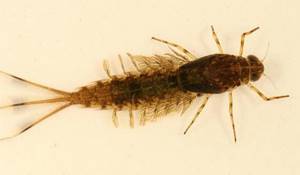
Surely you have repeatedly seen how small insects flock to the light of lanterns or the lights of steamships on warm and quiet evenings. These are mayflies. They are very easy to recognize. They have two pairs of transparent mesh wings, and the front ones are always much larger than the back ones. In calm weather it is incredibly interesting to watch their flight. They quickly flap their wings and fly up, after which they freeze and, as if on a parachute, descend down.
The Russian name “mayfly” itself speaks of the short period of existence of these creatures. They live from several hours to two days. Insects are interesting because their larval stage can last for several years, but at the same time, adult individuals have a very short period of time, which is equal to several hours or one day. This developmental paradox is difficult to explain.
One of the most ancient insects
The presence of long threads on the tail gives scientists the right to claim that this mayfly is one of the most ancient.
To confirm this, paleontologist Richard Necht from the Harvard Museum of Zoology picked up an unusual stone in one of the swampy ponds. When he cracked it open, he saw inside a fossil of an insect that was over three hundred million years old. After examining the print, scientists came to the conclusion that the print depicts an ancient mayfly at the end of its flight.
Read also: Pitohu is the only bird whose body is filled with poison
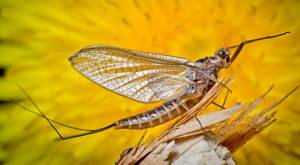
And in 2004, an entomologist from the University of Kansas, Michael Engel, discovered in a piece of flint shale the imprint of a similar moth, which is about four hundred million years old.
Mayfly biology
The entire external organization of mayflies is perfectly adapted not so much to flight as to soaring in the air. The peculiar flight of mayflies is sometimes called “dancing.” With several flaps of its wings, the mayfly rises to a certain height, then, spreading its tail filaments and stretching its rather long legs forward, it descends, as if on a parachute, and takes off into the air again. In the imaginal stage they do not feed, their mouthparts Essentially it is a balloon that makes flying easier. This is explained by the short life of the imago. It is no coincidence that they are called mayflies or ephemeris. Many species in the adult stage live only 2-3 hours, lay eggs in the water and die. Some species live 2-3 days. The life expectancy record for representatives of this order is two weeks.
Mayfly development
Almost the entire life of these insects (2-3 years) passes in the larval stage. Mayfly larvae have tracheal gills located on the sides of the abdominal segments. Larvae can always be found in fresh water bodies: among them there are swimming, crawling and burrowing forms. They can be predators, eating aquatic vegetation or filtering water.
Larvae prefer clean or slightly polluted water. Therefore, these animals can serve as an indicator of water quality in a lake or river.
Mayflies are the only insects in which it is not the imago that emerges from the nymph, but the winged phase, the subimago, which very quickly, within a few minutes, molts again.
The emergence from the water is a massive phenomenon and is accompanied by the birth of fifty, or even thousands of insects at once. If you look closely, you will notice that their flight is not at all chaotic. Males perform a mating dance: they constantly rise and fall, exuding special substances. Sensing the call, the females, in turn, flock to them to reproduce.
There are 3,281 known species in the world's fauna, including 157 fossil species.
The most common mayfly (Ephemera vulgata) and dipteran (Cloeon dipterum).
Common mayfly - Ephemera vulgata
Representatives
The common mayfly (Ephemera vulgata) is quite common in Europe, where it is found from May onwards. Their body length, not counting the caudal processes, with three long caudal filaments, is 17 - 19 mm. The larvae hatch in water and feed on animal food. At the bottom or on a steep bank they make themselves horizontal tubes about 52 mm long, where they usually stay.
A two-winged mayfly (Cloeon dipterum) with two tail filaments and no second pair of wings.
These insects can be considered useful animals, since their larvae serve as food for fish and their young.
natural-museum.ru
Needless to say, how successful fishing with sporting gear depends on knowledge of the lifestyle and, especially, feeding behavior of fish. The latter requires knowledge of the biology of the food items themselves, seasonal changes in their importance in the diet of fish. From this point of view, Sergei Afonin’s story about summer fishing with mayfly larvae is very interesting and useful. Let us only note that calling mayflies “butterflies” is incorrect. Mayflies form a separate order of insects, Ephemeroptera, and butterflies call the adult form of insects of a completely different order - lepidoptera, Lepidoptera.
Mystery
Once I was fishing on the Nerl River near the village of Poretskoye. It was July, the weather was sunny and summer. I used a mayfly larva as bait. I only fish with wires, moving from place to place downstream.
I walked about a kilometer and a half in this way, and the catch was just nonsense, about a dozen small, palm-sized roaches and breams. And then I came across a place that didn’t particularly stand out. The depth is about a meter and a half, there is a good current, one bank is sandy, the other, on which I was, is a small, about a meter, cliff, overgrown with sedge. And that's where it all began. Bite after bite followed, large roach were caught. A little later, good, half a kilo white bream, began to peck, and sometimes the ides bent the rod almost into a ring. It began to get dark, and although the float was no longer visible, the bite did not stop. The ten-liter can no longer contained the caught fish.
The next day I told a fisherman I knew about the successful fishing, and the two of them went to the same place. The bites became less frequent, but the fish were more impressive. When we had already caught, as they say, our fill, a fisherman came up to us and, seeing our catch, began to complain that he had walked half the river, and there was no bite. Considering that we had partially quenched our hunting passion, we made room. A sense of camaraderie is inherent in every fisherman. He stood a little lower downstream and also began to catch fish after fish. And again it pecked until it was completely dark. The next day we again rushed to the same place. Yesterday's fisherman was already there. We quickly collected our fishing rods and eagerly began fishing, but half an hour passed - no bite, an hour - nothing. By lunchtime, the three of us caught two roach. I went downstream, they remained with the hope that perhaps the bite would resume in the evening.
Having walked about four kilometers, I caught a roach and two bream from my heels, I wanted to “get away” and again I ended up at the “place”, and again it was nothing outwardly remarkable. There is no bite higher, no lower either, but in an area of 12-15 meters, just cast. And again, in two hours, I “filled” a full can.
The next day I asked a friend: “Did you catch anything last night?” “No,” he says, “they stood until darkness and left with nothing.” I asked everyone, but I could not get an intelligible answer explaining this phenomenon. I read all the issues of the anthology “Fisherman-Sportsman” in the regional library, but I couldn’t find the answer there either. I had to figure it out myself.
Solution
And then one day, fishing once again, in a place found in this way, I was busy until midnight, collecting the boat, fish, and gear in the car, when suddenly everything around me was transformed. Billions of white butterflies rose from the water and took flight. They were mayflies. They rose up, and then, spreading their wings, slowly gliding, sank down. I had an association that suddenly a snowstorm began and snow was falling in huge flakes. The next day I arrived at this place, although I assumed that today there would be no luck in this place, but for five days in a row in this place I caught very successfully, at least eight kilograms per evening.
This assumption was confirmed. The fish is gone. Then, over the course of many years, I observed this phenomenon, and every time after the departure of the mayfly, midges, or pusher mosquito, the fish went to another place. This, it turns out, is what keeps the fish so strong. No noise, no actions could scare the fish away from this place for long. A conclusion needs to be drawn from this. Whether you want it or not, whether it’s interesting to you or not, you are obliged to study the life of insects whose larvae live in water. Otherwise, you won't have any luck.
The mayfly butterfly got its name not by chance; this butterfly lives for one day, or more precisely, for several night hours. During this time, the butterfly performs its mating “dance” in the air, mates, after which the male dies, while the female drops her eggs into the water and also dies. Science knows more than 1,500 species of mayfly butterflies. All mayfly larvae develop in water. The larvae of mayfly butterflies are very different in appearance from each other, but they have a common structure - the fact that they all have tracheal gills on the first seven abdominal segments. Different species of mayflies lead different lifestyles. Some live in algae thickets, others dig burrows in clayey banks, there are larvae that live in silt, sand, under stones, attaching to the bottom of the stone. Mayfly butterflies live all over the globe, and everywhere fishermen who use the larva of a mayfly butterfly for bait become the owners the best catches, provided that you need to fish with this bait during the butterfly’s flight period.
How and where can you catch mayfly butterfly larvae?
During the summer months, especially during hot weather, the water level in the river drops noticeably. You need to find a section of the river with a steep clayey bank. Here, at the very edge of the water, look carefully at the clay bottom, and if you see a large number of burrows the size of a matchstick head, then you have probably discovered a colony of mayfly larvae. Take a shovel and carefully remove layers of clay soil 8-10 cm thick, place this soil on the shore a meter from the water and start scooping up river water with your hand and watering the layer of soil you extracted, while carefully watching the eroded soil and you will see small, slightly more than a centimeter, crustacean insects, which, I repeat once again, have tracheal gills on the seven abdominal segments. These are the larvae of the mayfly butterfly. Mayfly larvae can be found by turning over rocks. These larvae differ from the rest in their highly flattened shape.
To catch fish with larvae, I use the same gear as when fishing with natin. You can plant one or two larvae, this is quite enough. The larvae must be stored in a jar of water, since without water they will quickly die.
www.hunfi.ru
In today’s article I wanted to talk a little about entomology, but more precisely about what a fly fisherman needs to know about the insects that live in the area in which he is going to fish.
Many of you will say why do I need this, all the flies that imitate insects are already known, you can just take the right fly and go fishing. Unfortunately, if you don’t know or understand what the fish is currently feeding on and what insect it prefers now, your fishing may not be successful.
A fly fisherman certainly doesn't have to become an entomologist, but you do need to acquire a basic knowledge of insects.
First, let's look at what stages of development insects have; these stages are usually called metamorphosis or transformation.
As can be seen from the above diagram, the insects that we will talk about have different stages of development, and each stage has a different duration. The form of an insect at the stages of transformation is very different from adult insects in appearance. This fact applies more to insects with a full cycle of transformation, for example: butterflies, beetles, caddis flies, and flies.
Insects that do not have a complete transformation cycle are characterized by the fact that one form gradually transforms into another. The larvae, hatched from eggs, sometimes similar and sometimes different from the adult insect, do not pupate, but only molt.
After each new molt, the larva becomes more and more similar to an adult insect. It is these larvae that are of greatest interest to fly fishermen and are called nymphs or naiads.
Imitation of the mayfly nymph has become widespread among fly fishermen. Today we will talk about this insect.
Mayflies (Latin: Ephemeroptera) which means one-day or lasting no more than a day. At the moment, there are more than three thousand species of mayflies, which are distributed throughout the world with rare exceptions. Some of the diversity of these insects lives on the territory of Russia. Of course, I won’t list them; no one will remember anyway, and there’s no point in doing so. The main thing for you is to find out what specific species lives in the area where you are going to fish.
In the future I will talk about mayflies as a general average insect. As I already said, mayflies are insects with incomplete metamorphosis, and the first stage is the egg, which interests us little since it is not food for fish.
But we are especially interested in nymphs (larvae). First, let's look at the general characteristics of all mayfly nymphs.
The mayfly larva has a length of 6-30 mm excluding the tail, a relatively long abdomen and a short chest with wing rudiments. The nymph also has a clearly defined head with large eyes. The abdomen consists of 10 segments on the sides of which there are tracheal gills - tergalia.
The legs of the larva are well developed and are able to press against the body; due to this, the larva swims very well, making wave-like movements with its abdomen and using its tail as a horizontal fin.
The ability to swim, moving the abdomen up and down, and not left and right, is a distinctive feature of mayfly larvae from dragonfly larvae and stonefly larvae.
Mayfly larvae actively feed, unlike the imago and subimago stages, which do not feed at all. The larvae feed on organic debris and small algae; some species are predators and feed on ciliates and other small animals.
Mayfly larvae are an indicator of clean water and are very sensitive to the presence of chemical compounds in water.
According to their lifestyle, all mayfly larvae are divided into four types:
- FREE-FLOATING Nymphs (swimming nymphs)
They live mainly in calm waters between vegetation. They have an elongated cylindrical body and are able to swim well. The head is small, there may be two or three tail appendages. The size of the larvae is from 6 to 20 mm. Almost the entire group of this type is present in Russia.
- burrowing or burrowing nymphs
They live in stagnant or weakly flowing waters, with sandy and silty soil. They live in burrows dug in the ground and spend almost their entire lives in these burrows. Such nymphs have massive jaws and powerful legs, with which they dig the soil. They have three tail appendages. Sizes from 8 to 30 mm. This group includes “True Mayflies” (Ephemeridae), “Coastal Mayflies” (Polymitarcyidae), “River Mayflies” (Potamantidae). All three families are represented in Russia.
- Clinging or sticking nymphs (dinger)
They live in fast-flowing waters. The body is flat and not as long as that of previous nymphs. Adapted to cling to rocks in fast flowing water. There are three caudal appendages. Body length is from 6 to 16 mm. This group includes mayflies of the family “Seven-day mayflies” (Heptagem'idea).
- Crawler nymphs
They most often live in weakly flowing or standing waters. Such nymphs do not swim, but crawl through algae or sit on rocks. But such larvae are still similar to free-swimming nymphs. The body of such a larva is less elongated relative to actively swimming larvae. There are three caudal appendages. The length of the larvae is from 6 to 16 mm.
While on a body of water, it is advisable for a fly fisherman to determine whether a larva belongs to one group or another. The older the larva, the easier it is to determine its identity. The age of the larvae can be determined by the color of the wing primordia; in adult larvae ready for transformation into subimago, the wing primordia are dark.
Depending on the type of mayfly, their larvae can live in water from one to three or four years. During this time, the larva can molt up to 25 times. And so, when the time comes, the larva rushes upward, to the surface of the water, onto coastal plants or stones, to molt for the last time and turn into a subimago. At the moment, the larvae are especially vulnerable.
Flies that imitate this stage of insect development are called emergers. This is a purely fly fishing term and you will not find such a name in entomology. Flies of this type are very catchy at a certain moment.
Some larvae, having reached the surface of the water, die without throwing off the chitinous layer, and are carried away by the current of water. Such dead larvae also attract fish and, accordingly, there are flies that imitate such dead larvae.
The subimago stage of the mayfly has the English name Dun. Accordingly, the names of flies that imitate this stage contain this word, for example, Olive Dun, Sparkle Dun.
Sometimes this name is also found in imitation of the imago stage, this is due to the fact that the imago and subimago sometimes do not differ much in external characteristics. The subimago is an immature mayfly that can often fly as an adult.
The lifespan of adult mayflies ranges from several hours to ten days, depending on the species. The emergence of adult mayflies usually occurs en masse, and after mating, the males die immediately, and the females rush to the water to lay eggs.
It is worth noting that the emergence of mayflies does not always occur en masse and may not be noticed. Not numerous, that is, the rare emergence of single mayflies is of little interest to the fish.
That's all for now, I did not describe in great detail each stage of mayfly development, but simply wanted to explain the general development cycle of this insect, and how important it is for fly fishermen to understand this.
You can find more detailed information on the Internet, but first you should determine what types of mayflies live in your reservoirs and study them in more detail. And of course, it is important to trace this development on the reservoir.
If you offer flies to the fish that do not correspond to the stage in which the insect is at the moment, you will most likely fail in fishing.
In the end, I would like to note that, being an attractive insect for fish, the mayfly is not always the main food for fish in a certain body of water. And when a fly fisherman arrives at a reservoir, he needs to determine on the spot the main diet of the fish.
This can often be done by catching the first specimen of fish and opening the belly to see what its stomach is filled with. In this case, you will be able to determine exactly what the fish is feeding on at the moment, and it will not always be mayfly. We will talk about other insects that are food for fish in the following articles. If anyone is interested in this topic, I can provide links to more detailed material, please contact me.
Please rate the article
iangler.ru
Adult mayfly: reproduction
When mature they reach two or three centimeters. In the caudal section, the mayfly larva has three caudal, very long filaments, which are its distinctive feature. These threads help them swim, their action is similar to flippers or a tail.
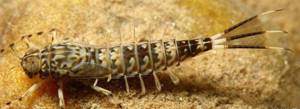
It must be said that an adult insect does not live long. Its life cycle is equal to the time required to participate in the mating flight, which takes place in the evening on the shore or over the river. From a whole swarm of males, only one representative quickly flies out and grabs the female, who is ready to reproduce. There are a large number of eggs in her body. She releases them into the water and dies herself. The morning after such a mating dance, all the banks and surface of the water are strewn with dead insects. This is how one mayfly larva ends its life cycle and a new life begins.
